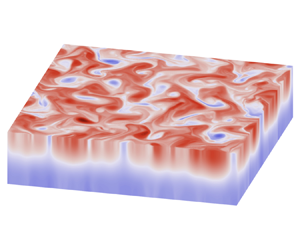Published online by Cambridge University Press: 19 May 2023

The transport induced by ocean mesoscale eddies remains unresolved in most state-of-the-art climate models and needs to be parametrized instead. The natural scale separation between the forcing and the emergent turbulent flow calls for a diffusive parametrization, where the eddy-induced fluxes are related to the large-scale gradients by a diffusion tensor. The standard parametrization scheme in climate modelling consists in adopting the Gent–McWilliams/Redi (GM/R) form for the diffusion tensor, initially put forward based on physical intuition and educated guesses before being put on firm analytical footing using a thickness-weighted average (TWA). In the present contribution, we provide a direct derivation of this diffusion tensor from the quasi-geostrophic (QG) dynamics of a horizontally homogeneous three-dimensional patch of ocean hosting a large-scale vertically sheared zonal flow on the  $\beta$ plane. The derivation hinges on the identification of a useful cross-invariant defined as the product of the buoyancy and QG potential vorticity fluctuations. While less general than the TWA approach, the present QG framework leads to rigorous constraints on the diffusion tensor. First, there is no diapycnal diffusivity arising in the QG GM/R tensor for low viscosity and small-scale diffusivities. The diffusion tensor then involves only two vertically dependent coefficients, namely the GM transport coefficient
$\beta$ plane. The derivation hinges on the identification of a useful cross-invariant defined as the product of the buoyancy and QG potential vorticity fluctuations. While less general than the TWA approach, the present QG framework leads to rigorous constraints on the diffusion tensor. First, there is no diapycnal diffusivity arising in the QG GM/R tensor for low viscosity and small-scale diffusivities. The diffusion tensor then involves only two vertically dependent coefficients, namely the GM transport coefficient  $K_{GM}(z)$ and the Redi diffusivity
$K_{GM}(z)$ and the Redi diffusivity  $K_R(z)$. Second, as identified already by previous authors, the vertical structures of the two coefficients are related by the so-called Taylor–Bretherton relation. Finally, while the two coefficients differ generically in the interior of the water column, we show that they are equal to one another near the surface and near the bottom of the domain for low-enough dissipative coefficients. We illustrate these findings by simulating numerically the QG dynamics of a horizontally homogeneous patch of ocean hosting a vertically sheared zonal current resembling the Antarctic Circumpolar Current.
$K_R(z)$. Second, as identified already by previous authors, the vertical structures of the two coefficients are related by the so-called Taylor–Bretherton relation. Finally, while the two coefficients differ generically in the interior of the water column, we show that they are equal to one another near the surface and near the bottom of the domain for low-enough dissipative coefficients. We illustrate these findings by simulating numerically the QG dynamics of a horizontally homogeneous patch of ocean hosting a vertically sheared zonal current resembling the Antarctic Circumpolar Current.